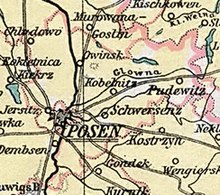Poznan East District

The Posen-Ost district in the Prussian province of Posen existed from 1887 to 1919. The former district is now part of the Polish Greater Poland Voivodeship .
size
The Posen-Ost district had a size of 655 km² in 1887, after the changes in 1900 it was 664 km².
history
The Prussian Posen-Ost district was formed on October 1, 1887 from the eastern half of the dissolved Posen district. The seat of the district office was the city of Poznan .
On April 1, 1896, the rural community Berdychowo-Piotrowo was given to the urban district of Posen ; on April 1, 1900, the rural communities of Jersitz, Sankt Lazarus and Wilda followed. On the same day, the city of Pudewitz , its police district, the rural communities Paczkowo, Sarbinowo and Sokolniki Gwiazdowskie as well as the manor districts Gwiazdowo and Puszczykowo from the Schroda district moved to the Posen-Ost district.
On December 27, 1918, the Wielkopolska uprising of the Polish majority against German rule began in the province of Posen , and in January 1919 the area of the Posen-Ost district was under Polish control. On February 16, 1919, an armistice ended the Polish-German fighting, and on June 28, 1919, with the signing of the Versailles Treaty , the German government officially ceded the Posen-Ost district to the newly founded Poland .
Population development
| year | Residents | source |
|---|---|---|
| 1890 | 46,896 | |
| 1900 | 39,139 | |
| 1910 | 49.119 |
In 1890 64% of the inhabitants of the district were Poles, 35% Germans and 1% Jews. The majority of the German residents left the area after 1919.
Population of the municipalities with more than 400 inhabitants (1910):
| Polish name | German name (1815-1919) | German name (1939-1945) | Population (1910) |
|---|---|---|---|
| Główna | Glowno village | Poznan East City | 5298 |
| Naramowice | Naramowice | Guntershausen | 605 |
| Pobiedziska | Pudewitz | Pudewitz | 3397 |
| Rataje | Rataj | Pflugdorf | 993 |
| Starołęka Mała | Klein Starolenka 1906–1919 Luisenhain |
Luisenhain | 1486 |
| Starołęka | Great Starolenka | Luisenhain | 512 |
| Suchy Las | Suchylas 1906-1919 Steimersdorf |
Steimersdorf | 502 |
| Swarzędz | Severity | 1939–1943 Schwaningen 1943–1945 Schwersenz |
3316 |
| Winiary | Winiary | Weeping | 5189 |
| Żegrze | Zegrze | Bamberg | 1481 |
politics
District administrators
- 1887–1899 Arthur Baarth (1858–1937)
- 1900–1918 Paul Steiner
elections
The district of Posen-Ost belonged together with the district of Posen-West and the city district of Posen to the Posen 1 Reichstag constituency . The constituency was won by candidates from the Polish parliamentary group in the Reichstag elections between 1887 and 1912 :
- 1887 Stephan Cegielski
- 1890 Stephan Cegielski
- 1893 Stephan Cegielski
- 1898 Stanislaus Motty
- 1903 Bernard von Chrzanowski
- 1907 Bernard von Chrzanowski
- 1912 Stanislaw Nowicki
Municipal structure
The towns of Schwersenz and from 1900 Pudewitz belonged to the Posen-Ost district . The (as of 1908) 96 rural communities and 47 manor districts were combined to form police districts.
Communities
At the beginning of the 20th century the following communities belonged to the district:
|
|
|
With a few exceptions, the Polish place names continued to apply after 1815, and several place names were Germanized at the beginning of the 20th century.
Web links
- District of Posen-Ost Administrative history and district list on the website territorial.de (Rolf Jehke), as of July 16, 2013.

